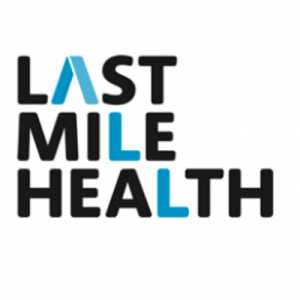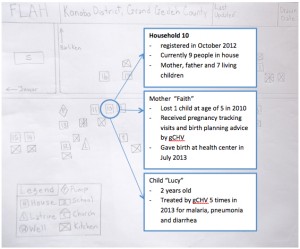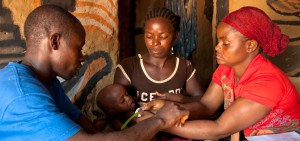Notes from the Field: CHW Community Mapping in Liberia

“For some of us that are far off from the clinic, the [gCHV] can reach us all the way in the bushes to make people stay healthy…You stay right there in the village, the people come to you to give you medicine. They teach us, make us to stay healthy, and make our surroundings clean.” — Community member, Flah
John, a general Community Health Volunteer (gCHV) living in the village of Flah in the remote Konobo district of Liberia, serves a community that is a 22-kilometer walk from the health facility. People in his village would carry the sick on hammocks, and they would sometimes die on the way. Flah, like so many other villages in rural Africa, was off the map.
But now, John is bringing access to lifesaving primary healthcare to every household in Flah. Tiyatien Health began training John and a cohort of gCHVs in October 2012 to learn to provide basic medical care to the people in their respective villages, but before he could begin providing care he needed to understand where to provide care. Thus the topic of the first training John and his gCHV peers received was mapping his catchment area. After being trained, John went around his village, indicating every household, water point, and latrine on a hand-drawn map, and then meeting and registering every single person in each home. After recording the name, age, and sex of each person in his village, he assigned each an identification number. He also interviewed every woman of childbearing age about her health, education level, and birth history. As new houses are built, as babies are born, as people move in and out, they are added to the map and the community registration.
So when John received training a few months later in integrated Community Case Management (iCCM)—which includes training modules in diagnosis and treatment of malaria, pneumonia, diarrhea, and malnutrition of children under 5—he knew exactly where to go. In the 19 households in Flah, 10 have children under the age of 5. John visits these 18 children at least once a month during active case finding, checking them for symptoms and asking mothers if any illnesses have occurred. He also tracks all of the pregnant women, and screens them monthly for complications before referring them to give birth at the facility. Every new child born is registered, and tracked closely over the critical first two months of life.
 The data collected by the gCHVs is then aggregated into a central database, where household level data can be easily tracked and managed, to understand health trends and indicators, and ensure proper follow-up with patients. The illustration above shows John’s map and the household data for a single house in Flah, reflecting John’s work with members of the household since he became an gCHV in October 2012.
The data collected by the gCHVs is then aggregated into a central database, where household level data can be easily tracked and managed, to understand health trends and indicators, and ensure proper follow-up with patients. The illustration above shows John’s map and the household data for a single house in Flah, reflecting John’s work with members of the household since he became an gCHV in October 2012.
This type of household mapping and registration is a simple tool that provides a continuously updated registry of the population as well as household level health indicators. It enables Tiyatien to track mortality and morbidity trends at the community level and to understand where and how interventions are working. The information on health indicators is subsequently fed into the national Health Management Information Systems, to ensure data synchronization and that health trends can be tracked on a more macro level.
As part of an ongoing effort by the Liberian Ministry of Health and Social Welfare to address any policy and implementation gaps in the current national gCHV program, the Ministry has elected to integrate Tiyatien Health’s community mapping process into the national community health system as the first training a gCHV receives. Mapping his or her community helps the gCHV identify and locate those that will require more express attention, such as pregnant women and children under five, and adopting this process will ensure that Liberia’s gCHVs are regularly visiting the homes where they are most needed.
There are now global movements to ensure that “every mother counts” and to create action plans to ensure survival for “every newborn.” The community mapping process will guarantee that in Liberia, every mother, every newborn, and every vulnerable person is monitored by a gCHV as well as their supervisors, and that gCHVs are able to identify where their life-saving assistance is most needed. Starting with one of the most remote districts in Liberia, where health workers such as John are seeing how this type of mapping can guide their work and enable them to target the community members that most need their help, the scale up of this mapping promises to make an enormous impact throughout all communities served by gCHVs in Liberia.
This post was authored by Tracy Slagle and Jenny Rabinowich of Last Mile Health/Tiyatien Health.
Check out Tiyatien’s Liberian CHW activities on the 1mCHW Campaign Operations Room.


Comments are closed